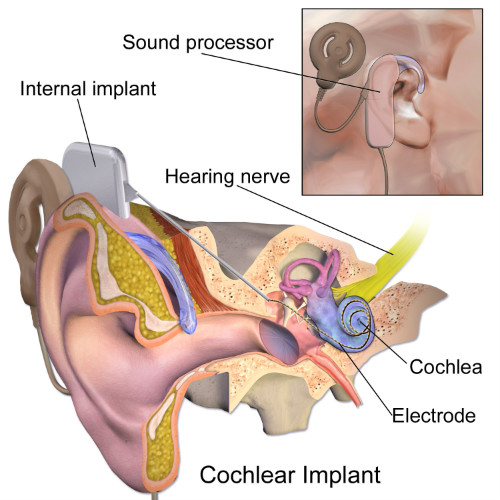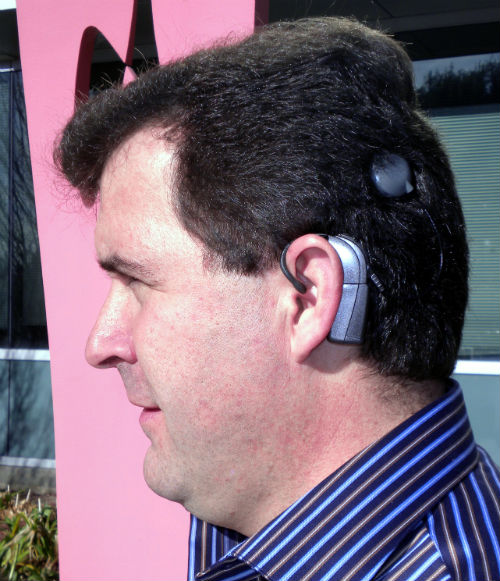- Restoration of hearing loss is linked to significant reduction in overall consumption of healthcare resources.
- Cochlear implantation was linked with greatly improved social engagement and quality of life for both hearers, and family, friends, and acquaintances.
- Social isolation was significantly decreased irrespective of the age of the implant recipient.
- Cochlear implantation was significantly superior to intervention with hearing aids for patients with single-sided postlingual deafness.
Strong data have shown that the treatment of postlingual hearing loss with hearing aids and cochlear implants (Figure 1 and 2) results in significant improvements in mental health quality of life. With hearing aids, the improvement comes in the short term. However, with cochlear implants, more profound hearing loss – or even deafness – can be reversed. With the implants, the majority of the improvement is observed at 6 months following implantation.

The authors of a prospective observational cohort study published recently in Laryngoscope observed improvements in 113 adults aged ≥50 years with postlingual hearing loss hearing loss following the administration of hearing aids or the implantation of artificial cochlea. “We observed differential effects of treatment depending on the level of baseline quality of life score with the greatest gains observed in those with the lowest scores,” the researchers reported.
Results of a Cochrane systematic review and meta-analysis published in International Archives of Otorhinolaryngology were nearly as positive for cochlear implantation. However, the reviewers stopped short of suggesting that the procedure be the standard of care of single-sided deafness (SSD).

The Laryngoscope Analysis
This study—and many of the studies included in the systematic review—have shown encouraging results for patients with single-sided deafness following cochlear implantation. The purpose of this study was to investigate the impact of hearing aid and cochlear implant use on quality of life in adults.
While serious complications are infrequent, they remain a concern. Nonetheless, patients with SSD often achieve clinically significant hearing that facilitates a meaningful social life and leads to significantly improved quality of life. However, according to the authors of the article in Laryngoscope, many of the studies “fail to provide a high level of evidence … [and] larger studies are necessary to define the tangible benefits of cochlear implantation in patients with SSD.”
Patients at a tertiary academic medical center were evaluated using the Medical Outcome Study Short Form-36 before intervention and at 6 and 12 months after intervention with hearing aids or cochlear implants. Change in score was assessed using linear mixed effect models adjusted for age, gender, education, and history of hypertension, diabetes, and smoking,” the authors noted.
Patients who received cochlear implants experienced
twice the improvement in hearing as did hearing aid users.
Results
The researchers reported that “A significant increase in Mental Component Summary score was observed in both hearing aid and cochlear implant users from baseline to 12 months.” Patients who received cochlear implants experienced twice the improvement in hearing as did hearing aid (Figure 3) users (hearing aid: 2.49 [95% confidence interval: 0.11, 4.88], P=0.041; cochlear implant: 4.20 [95% confidence interval: 1.85, 6.55], P<0.001), the researchers concluded.

The International Archives of Otorhinolaryngology Analysis
There is little doubt that binaural hearing is superior to unilateral hearing, specifically in the understanding of speech in noisy environments. Furthermore, unilateral hearing reduces one’s ability to localize sound. However, health insurance companies in the U.S. will rarely pay for bilateral cochlear implants in a single surgery. In the vast majority of cases the payors force patients to undergo the rigorous preparations for cochlear implantation twice—first for 1 ear and then, if clinical need can be demonstrated, again for the second ear. In most civilized countries, such as Canada and those in the European Union, single-surgery bilateral cochlear implantation is the standard of care.
This study provides a systematic review of recent studies evaluated the outcomes of speech discrimination, sound localization, and tinnitus suppression following cochlear implantation in patients with SSD. The reviewers searched the PubMed, Cochrane Library, and Lilacs databases for studies related to cochlear implantation. They were able to include 11 studies (n=127) in the analysis.
Conclusions
Treatment of hearing loss with hearing aids and cochlear implants results in significant increases in mental health quality of life. The majority of the increase is observed by 6 months following surgery. The authors of the study in Laryngoscope observed differential effects of treatment depending on the baseline quality-of-life score with the greatest gains observed in patients with the lowest scores.
The authors of the study published in the International Archives of Otorhinolaryngology noted that “Although some studies have shown encouraging results on cochlear implantation and SSD, all fail to provide a high level of evidence. Larger studies are necessary to define the tangible benefits of cochlear implantation in patients with SSD.”
“Outcomes regarding enhancement of sound localization, speech perception, and, mainly, improvement of tinnitus are promising indications as well; however, high quality studies are required before standardizing cochlear implantation as a treatment for single-sided deafness. Nonetheless, the results obtained up to this point from cochlear implantation in patients with single-sided deafness are encouraging in deeming this procedure a reasonable treatment. Given that the cochlear implant seems to bring greater benefits than contralateral routing of sound (CROS) and osseointegrated implants, it should be the first choice of treatment for patients with SSD in that which pertains to satisfactory selection criteria,” they concluded.
